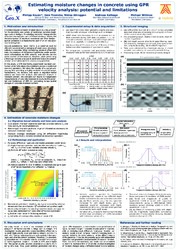Estimating moisture changes in concrete using GPR velocity analysis: potential and limitations
2018Poster
Englisch
Förderer: Geo.XFörderer: DFG
 |
Dokument öffnen: |
Chloride-induced corrosion of steel rebars is a key problem
for the durability and safety of reinforced concrete buildings
such as bridges. Penetrating rainwater transports the
chlorides into exposed parts of these buildings. Hence, the
characterization of moisture conditions and their tempospatial
variability is a fundamental part of an on-site practical
investigation.
Ground-penetrating radar (GPR) is a common tool for
efficient non-destructive imaging of small-scale structural
defects in concrete. When evaluating constant-offset GPR
data, the analysis of diffraction hyperbolas yields quantitative
information on GPR velocity, and thereby on the
water content of the medium. However, when performing
a thorough velocity analysis to estimate moisture content,
precise information on time zero is a key problem.
In this study, a GPR monitoring experiment has been performed
under laboratory-like conditions across a reinforced
concrete specimen. We show the results of a typical processing
flow providing a highly-resolved structural image.
Furthermore, we develop and apply a migration-based
velocity and time-zero analysis and calculate changes in
moisture content. We compare our results to independent
measurements of concrete moisture to evaluate the potential
and limitations of GPR for estimating tempo-spatial
changes in concrete moisture content.

